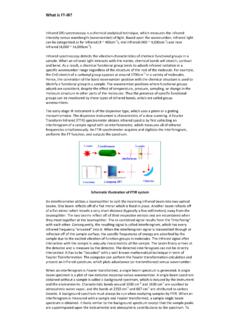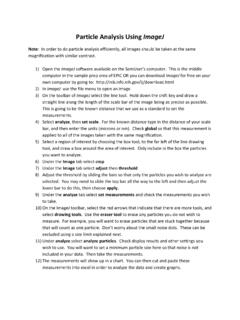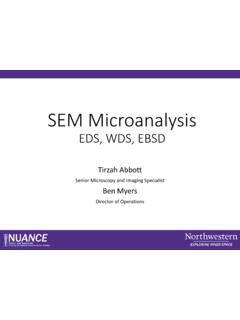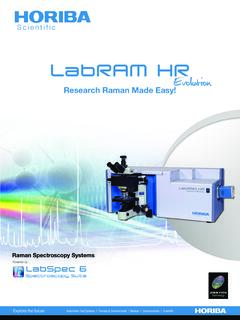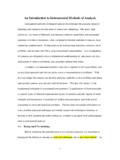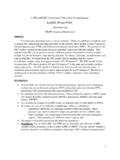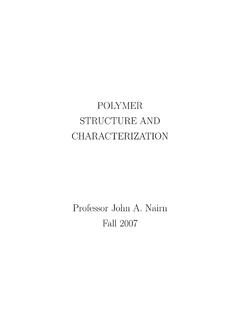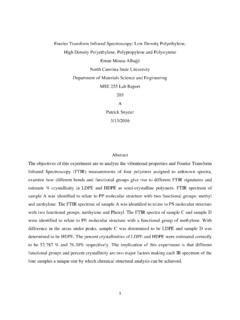Transcription of How to prepare IR samples? - NUANCE Center
1 how to prepare ir samples ? 1. Materials for sample preparation The following table lists the typical IR materials for various applications. These IR materials are used for IR window or diluents. It is worthy noting that hygroscopic materials are suitable for organic samples while non hygroscopic materials are used for water containing samples . 2. Sample preparation for transmission analysis 2. 1 Solid samples ( ) Thin plate samples You can use standard magnetic plate sample holder. ( ) Powder samples You can press powder into a pellet. In this method, you can select different diluents (matrixes) for various applications. For mid IR frequency range, KBr, KCl or diamond dust can be used.
2 For far infrared testing, high density polyethylene (HDPE) or diamond dust is suitable. For near infrared analysis , CsI or KBr can be selected. You can prepare a KBr Pellet as follows: (a) The powder sample and KBr must be ground to reduce the particle size to less than 5 mm in diameter. Otherwise, large particles scatter the infrared beam and cause a slope baseline of spectrum. (b) Add a spatula full of KBr into an agate mortar and grind it to fine powder until crystallites can no longer be seen and it becomes somewhat pasty and sticks to the mortar. (c) Take a small amount of powder sample (about of 2% of the KBr amount, or just enough to cover the tip of spatula) mix with the KBr powder.
3 Subsequently grind the mixture for 3 5 minutes. (d) Assemble the die set as shown in the drawing. When assembling the die, please add the powder to the 7mm collar. Put the die together with the powder into the Qwik Handi Press. Press the powder for 2 minutes to form a pellet. A good KBr pellet is thin and transparent. Opaque pellets give poor spectra, because little infrared beam passes through them. White spots in a pellet indicate that the powder is not ground well enough, or is not dispersed properly in the pellets. (e) Disassemble the die set and take out the 7mm collar. Put the collar together with the pellet onto the sample holder. (f) Please clean the die after you finish your experiment.
4 It is worthy noting that Br from the KBr can often replace ligands in the compound whose spectrum is desired. Liquid samples ( ) Making a sandwich To prepare a liquid sample to IR analysis , firstly place a drop of the liquid on the face of a highly polished salt plate (such as NaCl, AgCl or KBr), then place a second plate on top of the first plate so as to spread the liquid in a thin layer between the plates, and clamps the plates together. Finally wipe off the liquid out of the edge of plate. You can mount the sandwich plate onto the sample holder. After finishing your experiment, clean the plates with isopropanol (No water!) and return them to the desiccators.
5 Precaution: Volatile liquid can t be prepared with this method, because it will evaporate while its spectrum is being obtained. If the liquid sample is toxic or smelly, please don t use this method. In addition, NaCl and KBr are dissolved into water, and thus they can t be used for aqueous samples . ( ) Using a liquid cell The thermo Nicolet demountable pathlength cell is designed for liquid sample. Assemble the cell as shown in the drawing. Then use a syringe to fill the liquid into the cell. Finally seal the cell. 3. Sample preparation for ATR analysis The strongly infrared adsorbing materials such as rubbers, polymer films and aqueous solutions can be analyzed by the attenuated total reflection (ATR) technique.
6 Minimum or no sample preparation is required for ATR analysis . There are two kinds of crystals available at our laboratory, , 45 ZnSe and 45 Ge. Solid samples For solid samples , please use the flat crystal. To obtain the best results, the recommended sample dimension is 75 90mm long 16 25mm wide <4mm thick. The sample surface must be flat, otherwise intimate contact between the sample and the ATR crystal can not be obtained. Firstly place a sample on top surface of the crystal. Then place the gripper plate on the sample. Adjust the pressure applied to the gripper plate to ensure the consistent contact is achieved between the crystal and the sample.
7 Precaution: if you find a considerable force is necessary to overcome the resistance, STOP! Excessive pressure can crack and permanent damage the crystal. Also, the crystal must be keep clean and scratch free. Scratches affect the sample/crystal contact and thus have significant influence on the depth of penetration. Liquid samples For liquid samples , please use the trough crystal. Fill the trough plate with your liquid sample. Then place the cover over the trough plate. Precaution: Ensure the liquid sample does not attack the crystal. After you have finished your experiment, clean up the crystal using proper solvents (Acetone or water can be used for ZnSe and Ge).
8 4. Sample preparation for PM IRRAS measurement Typically, you can deposit a metal film on the regular glass slide (or silicon wafer). The metal/glass combination can be acted as the reference sample. In addition, you will deposit a monolayer (or organic film) over the metal film. Hence, you will have two samples , , the metal/glass combination and the monolayer/metal/glass composite. The recommended dimension of sample is 55~75mm x 17~25mm. References: Sampling catalogue, Thermo Nicolet.
